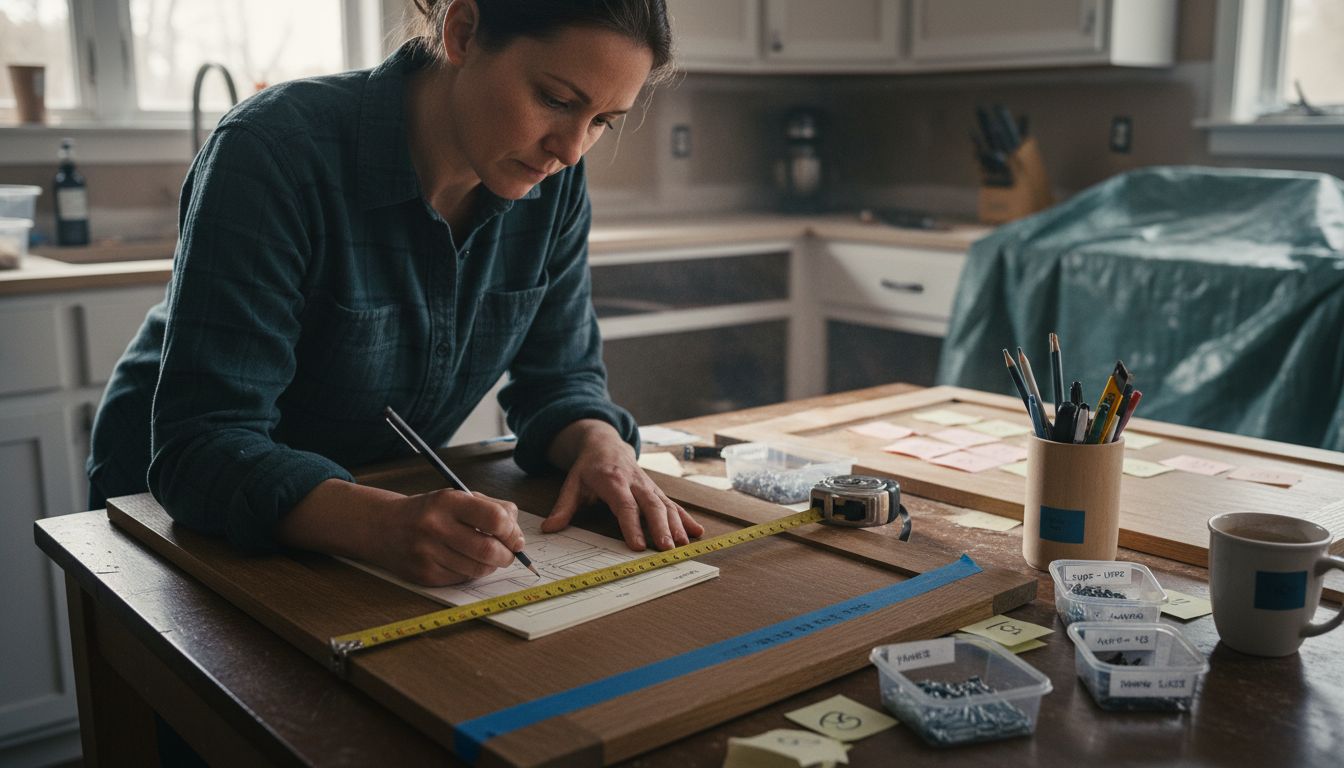Kitchen Door Removal Process for a Seamless Renovation
Did you know that over 70 percent of homeowners tackle kitchen renovations themselves each year? Choosing a hands-on approach can save money, but it comes with plenty of preparation and planning. By getting ready with the right tools, clearing your workspace, and documenting each step, you set yourself up for a hassle-free kitchen door removal. Discover practical ways to manage every stage safely so your project runs smoothly from start to finish.
Table of Contents
- Step 1: Gather Required Tools And Materials
- Step 2: Prepare The Kitchen For Removal
- Step 3: Label And Document Door Placement
- Step 4: Detach Hinges And Handles Safely
- Step 5: Inspect And Store Removed Doors
Quick Summary
| Key Point | Explanation |
|---|---|
| 1. Assemble a comprehensive toolkit | Gather essential tools like screwdrivers, a drill, and a measuring tape for effective door removal. |
| 2. Prepare your kitchen space thoroughly | Clear countertops and turn off utilities to create a safe working environment before starting the removal. |
| 3. Document door measurements accurately | Create sketches and record precise metrics to streamline ordering and installing new doors later. |
| 4. Remove hinges and handles carefully | Use appropriate screwdrivers and clamps to prevent damage to the doors during the removal process. |
| 5. Inspect and store doors properly | Examine for damage and store doors flat in a dry area to maintain their condition for potential reuse. |
Step 1: Gather Required Tools and Materials
Removing a kitchen door requires strategic preparation and the right equipment. Before diving into the project, you will need to assemble a comprehensive toolkit that ensures a smooth and efficient removal process.
Your essential toolkit should include precision measuring tools like a measuring tape and spirit level to guarantee accurate alignments. According to GFD Homes, you will want an electric drill with multiple drill bits for versatile work, alongside a sturdy hammer and sharp chisel for detailed adjustments.
Additional crucial tools include a saw for potential trimming, a rubber mallet for gentle tapping, and screwdrivers both Phillips and flathead to handle various fastener types. Remember to grab plastic-sheathed frame fixing screws measuring at least 8x100mm for potential reinstallation work.
Pro Tip: Always prioritise safety. Wear protective gloves and safety goggles throughout the removal process to prevent potential injuries.
Dont forget supplementary materials like silicone sealant and an applicator gun which might be useful for finishing touches or addressing any minor gaps during your kitchen door renovation.
Here’s a summary of essential tools and materials required for kitchen door removal:
| Tool / Material | Primary Use | Special Notes |
|---|---|---|
| Measuring tape | Accurate measurements | Essential for fit checks |
| Spirit level | Ensure straight alignment | Use before reinstallation |
| Electric drill | Remove/install screws | Use with various drill bits |
| Hammer & chisel | Detailed adjustments | For trims and hinge recess |
| Saw | Cutting/trimming doors | For resizing if necessary |
| Rubber mallet | Gentle tapping | Prevents wood damage |
| Phillips screwdriver | Remove crosshead screws | Common for hinges |
| Flathead screwdriver | Remove slotted screws | Use on various fasteners |
| Frame fixing screws | Secure reinstallation | 8x100mm plastic-sheathed |
| Silicone sealant | Fill minor gaps | Apply for finishing touches |
| Safety gloves | Hand protection | Always wear for safety |
| Safety goggles | Eye protection | Essential throughout process |
| Applicator gun | Apply silicone sealant | For clean and controlled finish |
With your toolkit assembled, you are now ready to move forward with confidence and precision in your kitchen door removal project.
Step 2: Prepare the Kitchen for Removal
Before you start removing your kitchen door, preparing the space is critical for a smooth and safe renovation process. This step involves strategic clearing and disconnecting essential utilities to create a safe working environment.
According to DIY Doctor, the first task is to completely clear out your kitchen. Empty all cupboards and clear your worktops entirely. Consider setting up a temporary kitchen space in another room where you can still prepare basic meals.
Utility management is your next priority. Turn off electricity at the main fuse board to ensure electrical safety during your renovation. Then carefully turn off the water supply at the mains – pro tip: remember to fill your kettle first so you have drinking water available.
Practical Advice: Keep an electric kettle and microwave in your temporary kitchen setup to maintain some cooking functionality during the renovation.
Next, disconnect your sink and drain lines. Carefully remove any connected appliances to prevent potential damage. As recommended by DIY Doctor, only begin removing your old kitchen after confirming you have all new units and appliances to avoid last-minute complications.
With your kitchen now prepared, you are ready to move forward to the next stage of your door removal project. Make sure you have all your tools and safety equipment on hand for the upcoming steps.
Step 3: Label and Document Door Placement
Measuring and documenting your kitchen doors is a crucial step that will save you significant time and potential headaches during your renovation project. Proper documentation ensures you have a precise record of every door’s specifications and placement.
According to UK Kitchen Doors, start by creating simple front view sketches of each kitchen section. Include all planned changes and draw a comprehensive sketch of each wall. This visual mapping will become your renovation blueprint.
When measuring doors, always measure the inside edge to edge. As recommended by UK Kitchen Doors, record measurements in millimetres using the Height x Width format. For instance, a door might be documented as 570 x 496 mm.
Pro Tip: When specifying hinge drilling, always view the door from the front with it closed to determine left or right hand orientation.
Create a systematic numbering system for your doors. List each door with its specific measurements, hinge drilling details, and any accompanying panels or accessories. This meticulous approach will streamline the entire ordering and installation process.

Pay special attention to hinge hole placement. Measure from the top or bottom edge of the door to the centre of the hinge hole, ensuring precision in your documentation.
With your doors carefully measured and documented, you are now prepared for the next critical stage of your kitchen renovation project.
Step 4: Detach Hinges and Handles Safely
Removing kitchen door hinges and handles requires precision and careful technique to prevent unnecessary damage to your cabinetry. This step is crucial for ensuring a smooth renovation process and preparing your doors for potential replacement or respray.
According to Wickes, start by carefully examining the hinge plates attached to the cabinet interior. Most hinge plates come with pre-inserted screws which simplify the removal process.
Begin by using an appropriate screwdriver to systematically loosen and remove the screws securing the hinges. Work slowly and methodically to avoid stripping the screw heads or causing unnecessary damage to the surrounding woodwork.
Safety Tip: Keep all removed screws and small hardware components in a clearly labelled container to prevent misplacement during your renovation.
When detaching handles, precision becomes even more critical. Wickes recommends using a clamp and a piece of timber offcut to support the door and prevent splintering during handle removal. This technique helps maintain the door’s structural integrity.
Carefully unscrew each handle using a screwdriver that perfectly matches the screw head. Avoid applying excessive force which could potentially damage the door surface or the handle mechanism.
With hinges and handles now safely removed, you are prepared for the next phase of your kitchen door renovation project.
Step 5: Inspect and Store Removed Doors
After carefully removing your kitchen doors, the next critical step is thorough inspection and strategic storage. This stage helps preserve your doors and prepares them for potential future use or replacement.
Carefully examine each door for any existing damage such as scratches, warping, or structural weaknesses. Look closely at the edges, hinges, and surface areas to understand their current condition. This assessment will help you decide whether the doors can be reused or need complete replacement.
According to DIY Doctor, this is an ideal moment to consider broader renovation opportunities. While inspecting your doors, you might also want to evaluate the surrounding wall conditions and plan for potential repairs or improvements.
Pro Tip: Wear protective gloves during inspection to prevent additional damage and protect yourself from potential splinters or sharp edges.
For storage, choose a clean dry area away from direct sunlight and moisture. Lay doors flat on a smooth surface preferably covered with a soft cloth or protective material. If stacking multiple doors, place protective padding between them to prevent scratching or additional wear.
As recommended by DIY Doctor, this is also an opportune time to plan any additional kitchen improvements like wall repairs, painting, or flooring updates.
With your doors carefully inspected and stored, you are now ready to move forward with the next phase of your kitchen renovation project.
Transform Your Kitchen Renovation with Professional Respray Services
Removing kitchen doors can be a challenging task filled with precision steps and careful handling of hinges and fittings. If you are feeling overwhelmed by measuring, documenting, and detaching your kitchen doors, you are not alone. Many homeowners struggle with protecting their investment and ensuring a flawless finish without damage or disruption.

Discover how our expert kitchen respray service takes the stress out of refurbishment. We respray your kitchen doors in situ, preserving your existing setup and avoiding complicated removals. Don’t risk costly damage during the door removal or handle detachment stage; instead, let professionals handle the process with care and skill. Explore more about kitchen transformations on our Uncategorized Archives and visit our homepage to book your consultation today. Take the first step to a stunning, hassle-free kitchen renewal that saves time and protects your home.
Frequently Asked Questions
What tools do I need for the kitchen door removal process?
To successfully remove a kitchen door, gather essential tools like a measuring tape, electric drill, screwdrivers, and safety goggles. Ensure you have a sturdy hammer, chisel, and rubber mallet on hand for adjustments and gentle tapping.
How do I prepare my kitchen for removing the door?
Start by completely clearing out your kitchen, including emptying cupboards and clearing countertops. Disconnect utilities by turning off the electricity and water supply to create a safe working environment before beginning the removal.
What should I measure when documenting my kitchen doors?
Document each door’s measurements by measuring from edge to edge, recording them in millimeters using the Height x Width format. For example, if a door is 570mm high and 496mm wide, note it as 570 x 496 mm for reference.
How do I safely detach hinges and handles from the kitchen door?
To detach hinges and handles, use the appropriate screwdriver to remove the screws carefully, ensuring you work methodically to prevent damage. Store all removed screws in a labeled container for easy reinstallation later.
What should I do after removing the kitchen doors?
After removal, inspect each door for damage like scratches or warping to determine if they can be reused or need replacement. Store the doors in a clean, dry area on a smooth surface, laying them flat with protective padding in between.
How can I ensure a seamless renovation after removing the doors?
To ensure a seamless renovation, take the time to assess the surrounding areas for any repairs needed and plan any additional improvements. Create a timeline for updates, aiming to complete any necessary changes within 1-2 weeks to keep the project on track.
